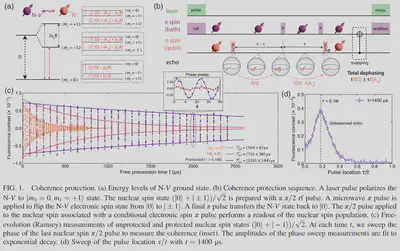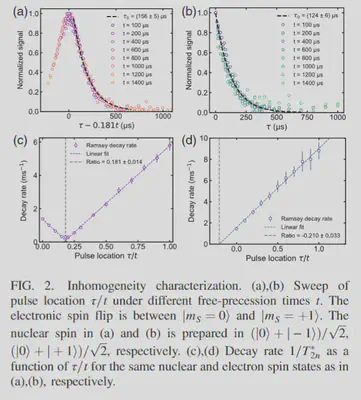Reading Paper 20230914
Characterizing temperature and strain variations with qubit ensembles for their robust coherence protection
Jiheng Duan, jiheng.duan@rochester.edu, 09/14/2023
Paper Information
- DOI: 10.1103/PhysRevLett.131.043602
- Date: 25, July., 2023
- Author: Guoqing Wang, Ariel Rebekah Barr, Hao Tang, Mo Chen, Changhao Li, Haowei Xu, Andrew Stasiuk, Ju Li, and Paola Cappellaro
Motivation
- Solid-state spin defects (NV center in diamond here) suffer from dephasing due variations of intrinsic quadrupole and hyperfine interactions.
- Using electron spins to refocus variations of interactions (quadrupole and hyperfine) to achieve long nuclear spin free evolution. Known as unbalanced echo.
- This unbalanced echo technique and be used to sensing temperature and strain variations in materials with nanoscale resolution.
Unbalanced echo
-
It involves flipping an ancillary qubit (here the N-V electronic spin) midway through the free precession period of the target qubit (here the nitrogen nuclear spin).
-
The flip time $\tau$ is asymmetric - it does not split the free precession time t into two equal halves, hence “unbalanced”.
-
This echo sequence cancelles out low-frequency noise from interaction variations, acting like a spin echo.
-
However, it preserves the useful quantum phase information accumulated during the free precession, unlike a regular spin echo.
Setup system
- The system diagram and energy levels are shown in Fig.1 (a).
- The nuclear spin (n spin) is qubit and N-V center electron spin (e spin) is bath.
- e spin state is switched between $|m_S = 0\rangle$ and $| m_S = \pm 1 \rangle$.
- n spin contains single quantum (SQ) transitions between $|m_I = 0\rangle$ and $|m_I = \pm \rangle$ which have six different frequencies: $\omega_{1,2} |Q| \pm |\gamma_n B|$, $\omega_{3,4} = |Q| \mp |A_{zz}| \pm |\gamma_n B|$, and $\omega_{5,6} = |Q| \pm |A_{zz}| \pm |\gamma_n B|$, corresponding to the electron spin state $|m_S = 0\rangle$, $|m_S = -1\rangle$, and $|m_S = +1\rangle$, respectively.
- In a magnetic field $B$ aligned with the N-V center, the Hamiltonian of nuclear spin is given by $$ H_n = Q I^2_z + m_S A_{zz}I_z + \gamma_n B I_z $$ where $I_z$ is the spin-1 $z$ operator, and we assume the N-V electronic spin is in its eigenstate $|m_S\rangle$.
Pulse sequence
- The pulse sequence are shown in Fig.1 (b).
- The N-V center electron are polarized to state $|m_S = 0, m_I = +1\rangle$ by a laser pulse.
- The nuclear spin state $(|0\rangle + |\pm 1\rangle)/\sqrt{2}$ is prepared with a $\pi/2$ pulse (notice that ``$m_I = $’’ is omitted here for simplicity).
- Suppose we prepare nuclear spin state $(|0\rangle + |- 1\rangle)/\sqrt{2}$ and drive the spin state between $|m_S = 0\rangle$ and $|m_S = \pm 1\rangle$.
- The free evolution of nuclear spin state after time $t$ is given by $|\psi(t)\rangle = (|0\rangle + e^{i\phi}|-1\rangle)/\sqrt{2}$ with an accumulated quantum phase $\phi = \omega t$.
- At time $t - \tau$, we apply a $\pi$ pulse on the spin state, flipping the spin state from $|m_S = 0\rangle$ to $|m_S = \pm 1\rangle$, turning the level frequency from $|Q| - |\gamma_n B|$ to $|Q| \mp |A_{zz}| - |\gamma_n B|$.
- The accumulated phase and dephasing till now is $ \phi_0 + \delta\phi = -(|Q|-|\gamma_n B|)(t - \tau) + (\delta|Q| + \gamma_n \delta|B|)(t - \tau) $ where $\delta$ means variation. Why there is a minus sign behind $\phi_0$ ??? And why there is a plus sign behind the $\delta B$ term ???
- At time $t$, we apply another $\pi$ pulse on the spin state, flipping the spin state back to $|m_S = 0\rangle$. turning the level frequency back to $|Q| - |\gamma_n B|$.
- The accumulated phase and depasing in time interval $[t-\tau, t]$ is $\phi_0’ + \delta\phi’ = -(|Q| \mp |A_{zz}| - |\gamma_n B|)\tau + (\delta|Q| \mp \delta|A_{zz}| - \gamma_n \delta|B|)\tau$.
- Assume the flipped electron state is $|\m_S = +1\rangle$. The total accumulated phase and dephasing is given by $\phi = \phi_0 + \phi_0’ + \delta \phi + \delta \phi’$.
- In optically addressed solid-state spin ensembles, the laser heating introduces temperature variations $\delta T$. This temperature variation will induce the variation in quadrupole and hyperfine interaction (assume the variation of the magnetic file $\delta B$ is minimized when designing the experimental setup, and the small gyromagnetic ratio $\gamma_n/\gamma_r \sim 10^{-4}$ introduces negligible coupling to the magnetic noise).
- Therefore, one correlation can be made by expressing $\delta Q = \alpha_Q \delta T$ and $\delta A_{zz} = \alpha_A \delta T$.
- The total phase accumulation and dephasing becomes $$ \begin{aligned} \phi (\delta T) &= \varphi_0 + \delta\varphi \ &= -t Q + \tau A_{zz} + \gamma_n B t - (t\alpha_Q - \tau\alpha_A)\delta T, \end{aligned} $$ where $\varphi = -t Q + \tau A_{zz} + \gamma_n B t$ and $\delta \varphi = - (t\alpha_Q - \tau\alpha_A)\delta T$.
- If the pulse location $\tau/t$ is set to the ratio $\alpha_Q/\alpha_A$, the noise (dephasing) $\delta \varphi$ can will be completely canceled while the static part $\varphi_0$ still remain sensitive to the magnetic field.
Fitting, get $T_2^* $
- We use a Ramsey type pulse on the n spin, and map the dephasing on to the e spin and perform a measurement.
- The Ramsey signal $$ S(t) = [1 + \cos(\omega t)]/2, $$ where $\omega = \omega_0 + \delta \omega$. The $\delta \omega$ satisfies a zero-mean Lorenzian distribution with a half-width $\sigma = 1/T_2^$, the signal has an exponential decay envelope $\langle cos(\omega t) \rangle = \cos(\omega_0 t) e^{-t/T_2^}$ characterizing the loss of quantum information.
- By sweeping the phase $\phi$ and free evolution time $t$, we could measured the curve in Fig.1 (c).
- Fig.1 (d) shown a sweep of pulse location $\tau/t$ with $t=1400 \mu s$, where an unbalanced echo signal is observed at $\tau/t = 0.18$.

Characterization of temperature and stain distribution
- Based on the discussion of frequency noise $\delta \omega$, by probing the material dependent ratio $\alpha_Q/\alpha_A$, it can be used to characterize the temperature distribution in the material by analyzing the shape and decay constant in the unbalanced echo and free-evolution measurements.
- The Lorentzian distribution of the temperature with half-width $\sigma_T$, the dephasing factor becomes $$ e^{-t/T_{2n}^*} = ee^{-|t\pm (\alpha_Q/\alpha_A)t||\alpha_A| \sigma_T}, $$ for nuclear spin state $(|0\rangle + |\pm 1\rangle)/\sqrt{2}$, respectively.

Refocusing strong noise variations
C.f. Sec. Refocusing strong noise variations.